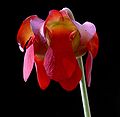Sarracenia leucophylla
| Sarracenia leucophylla subsp. var. | White trumpet | |||||||||||||||||||||||||||||||||||||||||||||||||||||||
|---|---|---|---|---|---|---|---|---|---|---|---|---|---|---|---|---|---|---|---|---|---|---|---|---|---|---|---|---|---|---|---|---|---|---|---|---|---|---|---|---|---|---|---|---|---|---|---|---|---|---|---|---|---|---|---|---|

|
|
| ||||||||||||||||||||||||||||||||||||||||||||||||||||||
| ||||||||||||||||||||||||||||||||||||||||||||||||||||||||
Sarracenia leucophylla, also known as the white pitcher plant, is a carnivorous plant in the genus Sarracenia. Like all the Sarracenia, it is native to the New World and inhabits moist and low-nutrient longleaf pine (Pinus palustris) savannas along the United States Gulf Coast, generally west of the Apalachicola River on the Florida Panhandle. The species is highly variable with respect to its pitchers, with plants in some localities reaching almost 1 metre in height, while in others, plants can be diminutive (such as the seldom seen 30 cm high dwarf form encountered at Garcon Point in Santa Rosa County, FL). S. leucophylla produces crimson flowers in the spring before its characteristically small spring pitchers. These are generally followed midsummer with flat non-carnivorous leaves known as phyllodia. Its most robust and handsome pitchers are then produced in the early autumn. It is one of the largest and showiest Sarracenia species, which has made it vulnerable to poachers as well as interest from the floral trade, in which the cut autumn pitchers often find use in arrangements. However, as is the case with most Sarracenia species, the greatest threat to S. leucophylla is loss of its unique wetland habitat to development along the Gulf Coast, as well as forest succession that was historically kept in check by fire.
Cultivation
In cultivation, S. leucophylla is generally less tolerant of stagnant water conditions and requires adequate soil drainage while still retaining requisite moisture levels to prevent root rot. Several clones are recognized: 'Schnell's Ghost', a yellow-flowered clone with little red in the pitchers (though not anthocyanin free); 'Hurricane Creek White', a group of predominantly white plants from Hurricane Creek, AL; 'Tarnok', a mutant form which produces a showy, although sterile, double flower; and 'Titan', an especially tall and robust form that may produce fall pitchers greater than 38 inches (97 cm) in height. Despite its native range in the southeast US, S. leucophylla is remarkably hardy and can be grown outside even in USDA zones 6 and colder with careful winter protection.
Propagation
Pests and diseases
Varieties
Gallery
References
- D’Amato, Peter. 1998. The Savage Garden. Berkeley. ISBN 0-89815-915-6
External links
- w:Sarracenia leucophylla. Some of the material on this page may be from Wikipedia, under the Creative Commons license.
- Sarracenia leucophylla QR Code (Size 50, 100, 200, 500)



